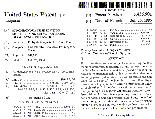 Cover Page
Cover Page
US Patent #5,436,901 Synchronous Time Division Multiplexing Using Jam-Based Frame Synchronization
ABSTRACT
If a transceiver has a message to send during an idle medium condition, it transmits a jam pattern onto the medium for a predetermined time (based on maximum network propagation delay). If a transceiver detects a jamming pattern, it inhibits its own transmissions and waits for the end of the jamming pattern. If multiple transceivers begin jamming within a propagation delay of each other (within the network vulnerable time), their jamming transmissions will not destructively interfere with each other. When jamming ceases, all transceivers begin a time slice progression. Thus, the end of the jamming period when all transceivers have finished jamming serves as a network-wide synchronization for the start of an implicit token time slice progression.
Phil Koopman -- koopman@cmu.edu